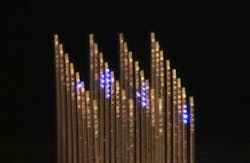3D optogenetics probe from MIT targets hundreds of individual neurons
Cambridge, MA--A new fiber-optic device created by biologists and engineers at the Massachusetts Institute of Technology (MIT) is the first 3D tool that can deliver precise points of light to a 3-D section of living brain tissue. The work is a step forward for a relatively new but promising technique called optogenetics that uses gene therapy to turn individual brain cells on and off with light. By using the new 3D "light switch" to better understand how the brain works, it could be used to create neural prostheses that could treat conditions such as Parkinson's disease and epilepsy.
One of the advantages of optogenetics is that this technology allows scientists to focus on one particular type of neuron without affecting other types of neurons in the same area of cortex. Probes that deliver electricity to the brain can manipulate neurons, but they cannot target individual kinds of cell, says Ed Boyden, a synthetic biologist at MIT, co-lead researcher on the paper, and a pioneer of optogenetics. Drugs can turn neurons on or off as well, he continues, but not on such a quick time scale or with such a high degree of control. In contrast, the new 3D array is precise enough to activate a single kind of neuron, at a precise location, with a single beam of light.
In an earlier incarnation, Boyden's device looked like a needle-thin probe with light-emitting ports along its length; this setup allowed scientists to manipulate neurons along a single line. The new tool contains up to a hundred of these probes in a square grid, which makes the device look like a series of fine-toothed combs laid next to each other with their teeth pointing in the same direction.
Each probe is just 150 microns across—a little thicker than a human hair, and thin enough so that the device can be implanted at any depth in the cortex without damaging it. The brain lacks pain receptors, so the implants do not cause any discomfort to the brain itself. As in the earlier model, several light-emitting ports are located along the length of each probe. Scientists can illuminate and change the color of each light port independently from the others. Adding a third dimension to the probe's light-delivery capabilities has allowed researchers to make any pattern of light they want within the volume of a cubic centimeter of brain tissue, using a few hundred independently controllable illumination points.
Neurons in the brain are not naturally responsive to light, so scientists sensitize these cells with molecules called opsins, light-detecting proteins naturally found in algae and bacteria. Genes for an opsin are transferred to the neurons in a mouse's brain using gene therapy, a process in which DNA is ferried into a cell via a carrier such as a harmless virus. The carrier can be instructed to deliver the DNA package only to certain types of cells.
Different colors of light turn different flavors of opsin on—blue might cause one opsin to activate a cell, while yellow might cause another opsin to silence it. Neurons that are sensitized with opsins gain these abilities to respond to light. The response of an individual neuron—whether to turn on or turn off—depends on the type of opsin it was sensitized with, and the color of light used to illuminate it. In this way, the tool gives neuroscientists an unprecedented level of control over individual neurons in the brain.
Teams from around the world are currently using the technology developed by Boyden’s group to study some of the most profound questions neuroscience tries to answer, such as how memory works, the connections between memory and emotion, and the difference between being awake and being asleep.
Although the new device is effective in bringing light to the brain, other challenges remain before optogenetics can be used for medical therapy, Boyden says. Scientists do not yet know for certain whether the body will detect the opsin proteins as foreign molecules and reject them. Gene therapy will also have to prove itself if neurons are to be sensitized with opsin effectively.
The demand for the tool is currently higher than his team can supply. Boyden says his group is excited about the possibility of commercializing the new 3D array, as one potential route that would make the devices available as quickly as possible to the neuroscience community.
The Optics Letters paper is available here.
SOURCE: OSA; http://www.osa.org/en-us/about_osa/newsroom/newsreleases/2012/a_3-d_light_switch_for_the_brain/

Gail Overton | Senior Editor (2004-2020)
Gail has more than 30 years of engineering, marketing, product management, and editorial experience in the photonics and optical communications industry. Before joining the staff at Laser Focus World in 2004, she held many product management and product marketing roles in the fiber-optics industry, most notably at Hughes (El Segundo, CA), GTE Labs (Waltham, MA), Corning (Corning, NY), Photon Kinetics (Beaverton, OR), and Newport Corporation (Irvine, CA). During her marketing career, Gail published articles in WDM Solutions and Sensors magazine and traveled internationally to conduct product and sales training. Gail received her BS degree in physics, with an emphasis in optics, from San Diego State University in San Diego, CA in May 1986.
